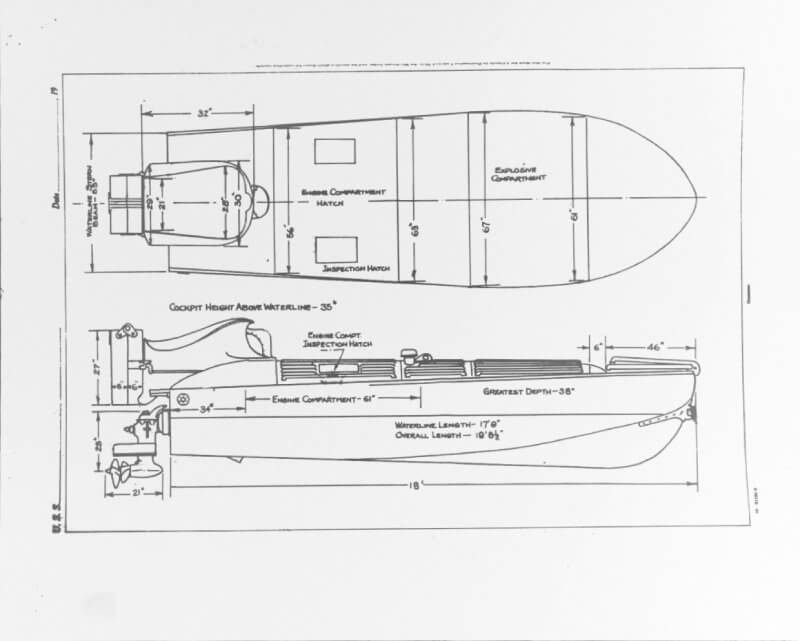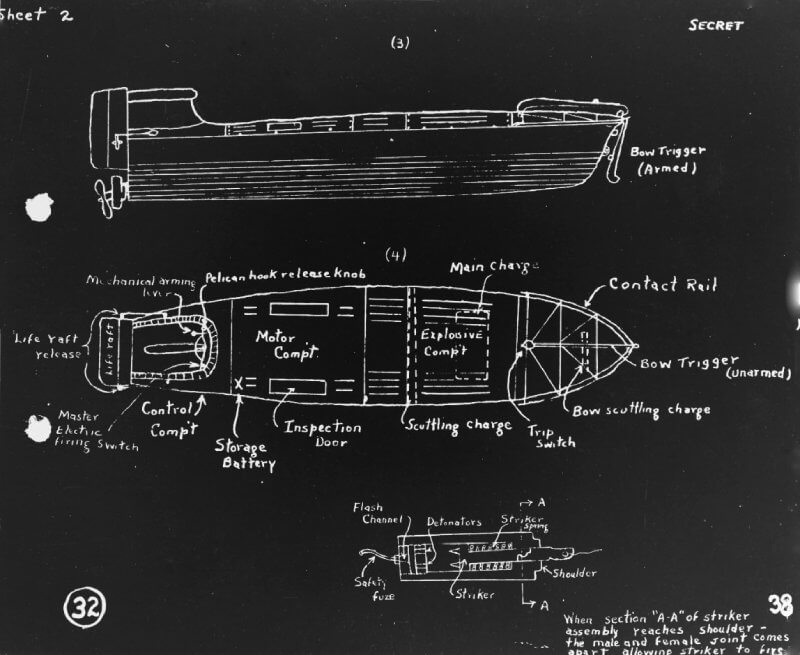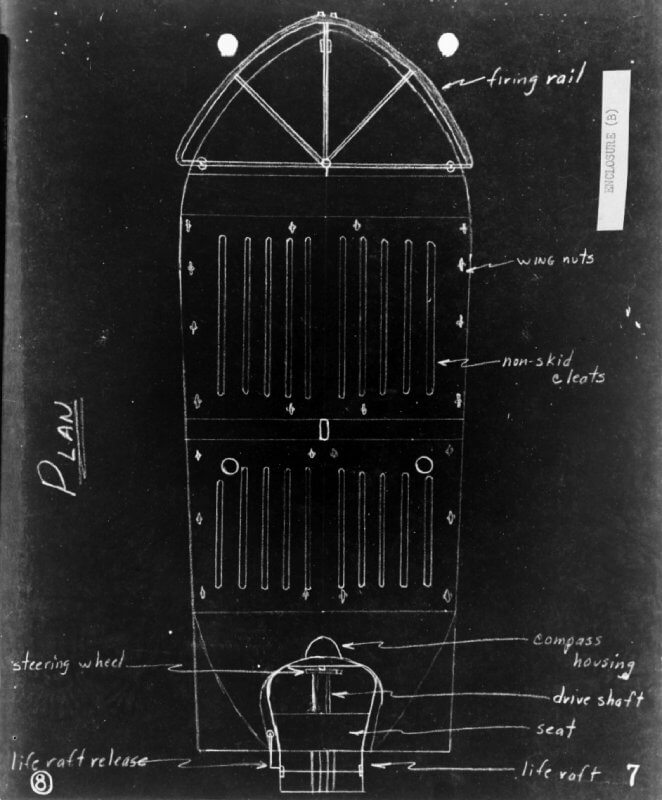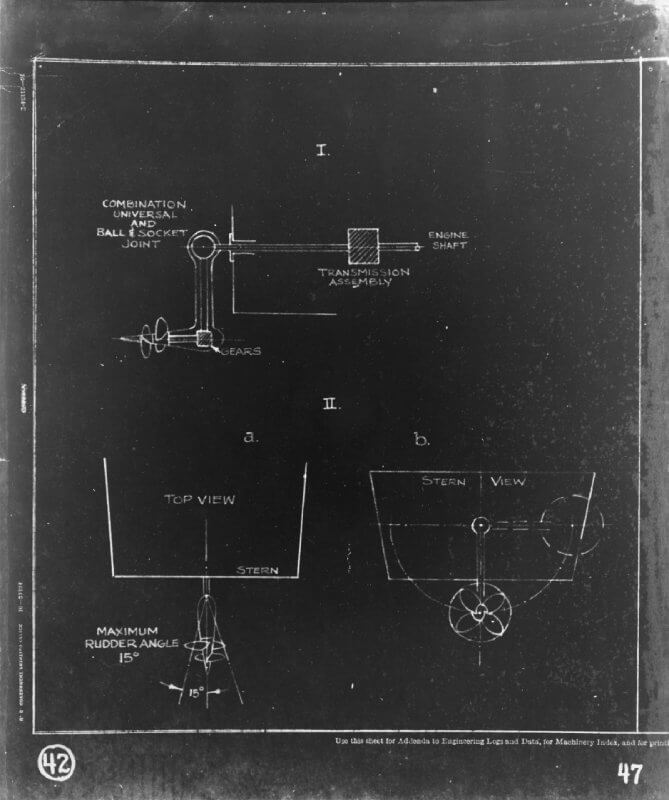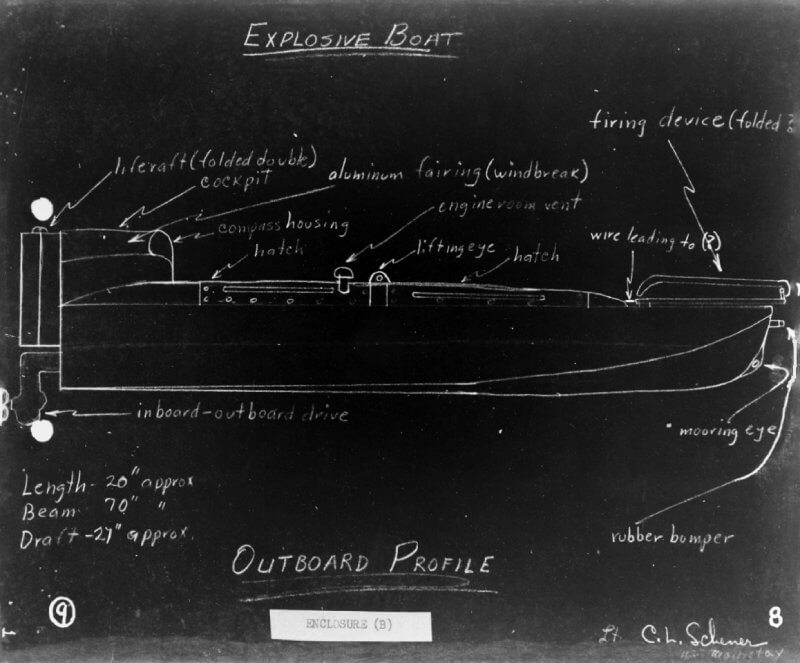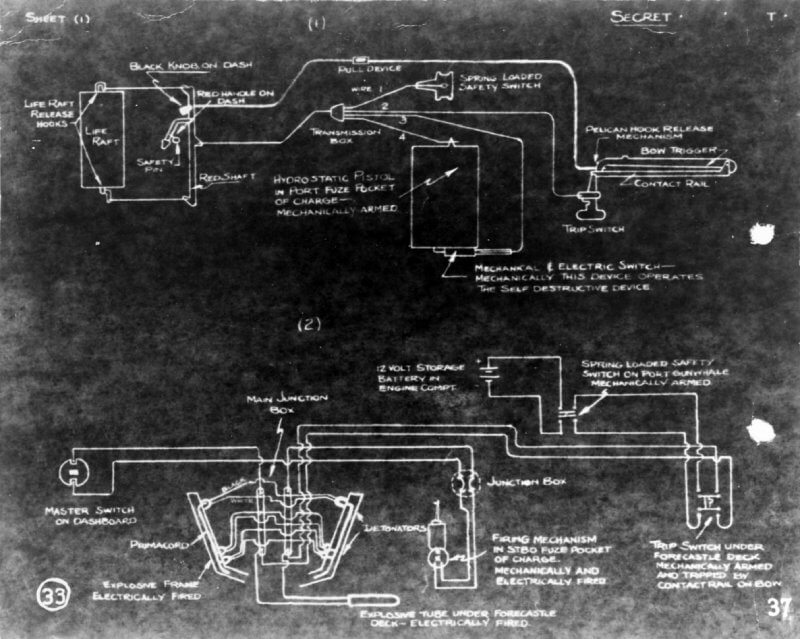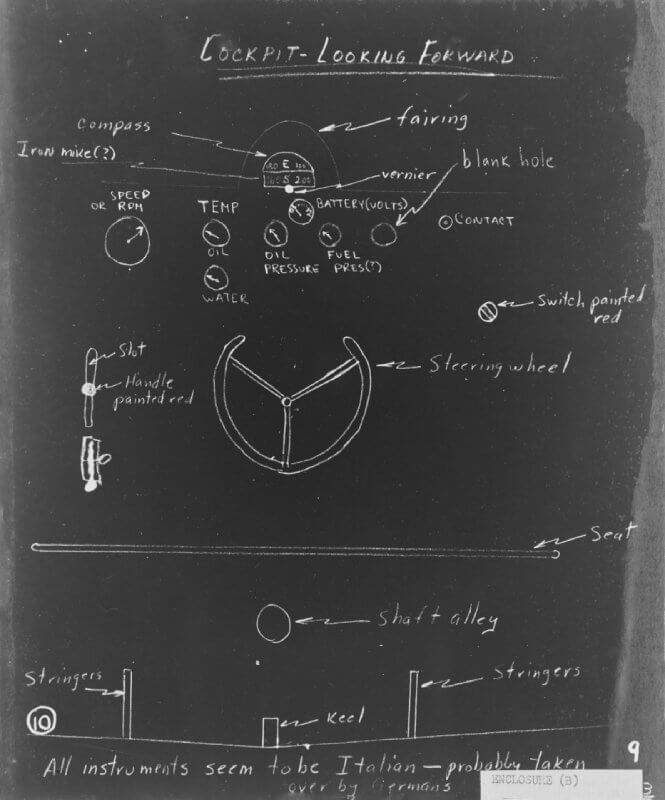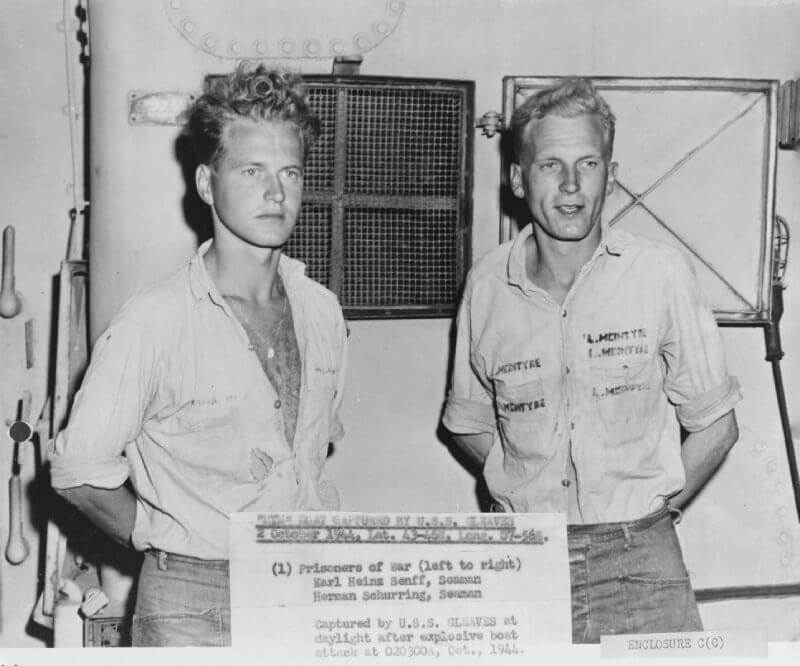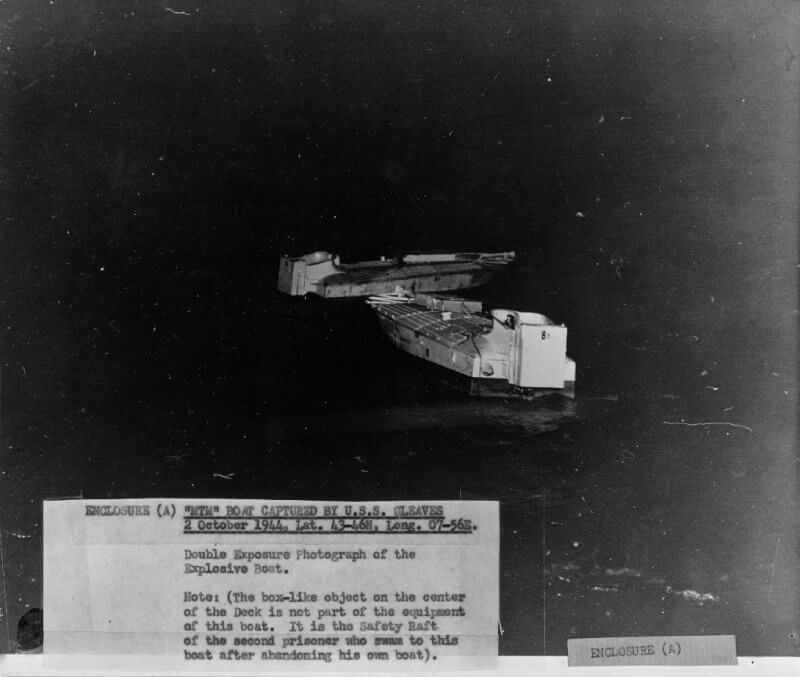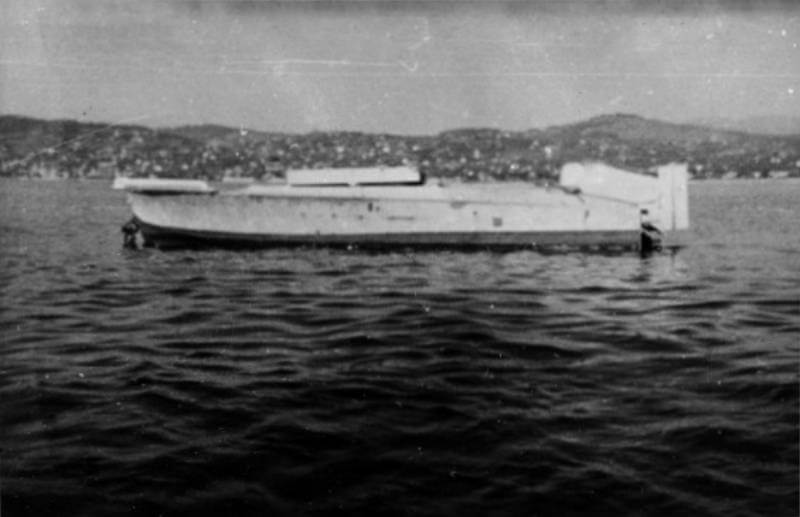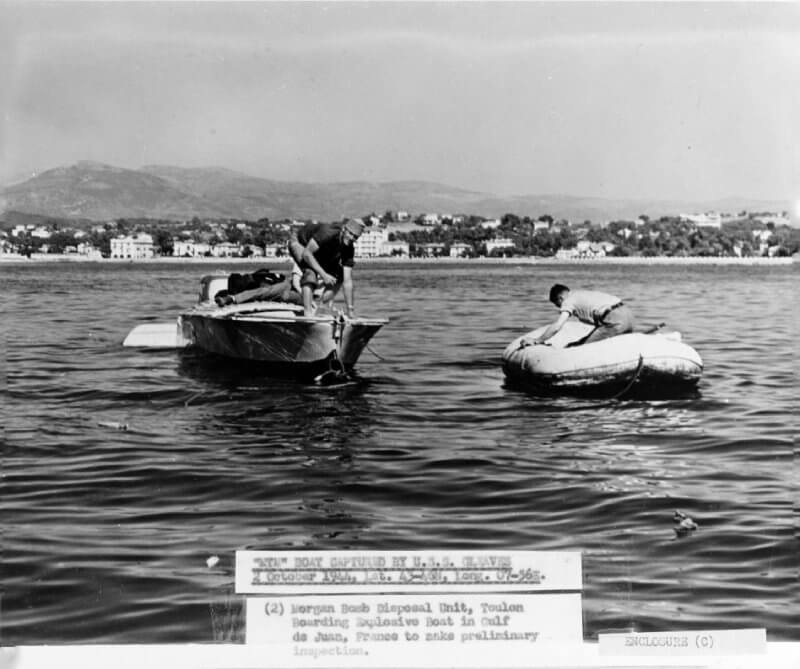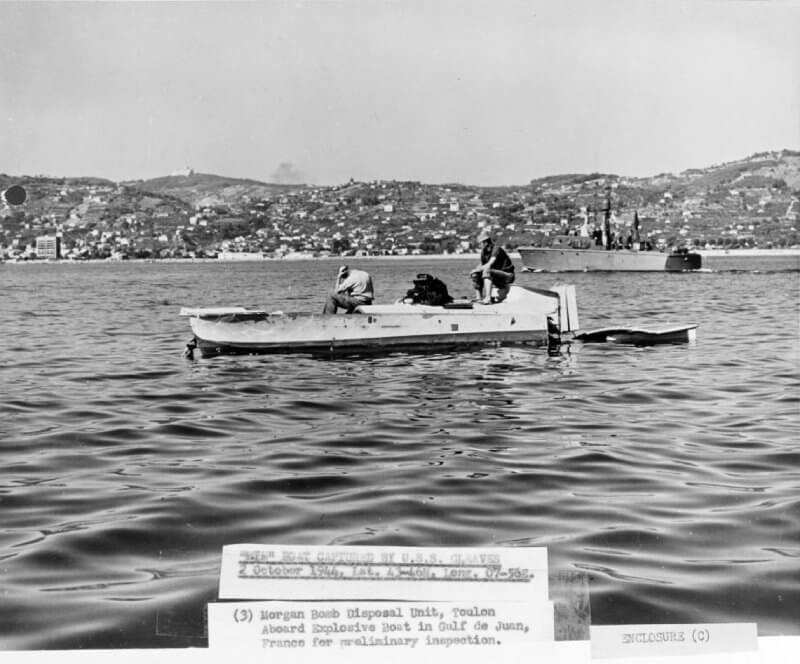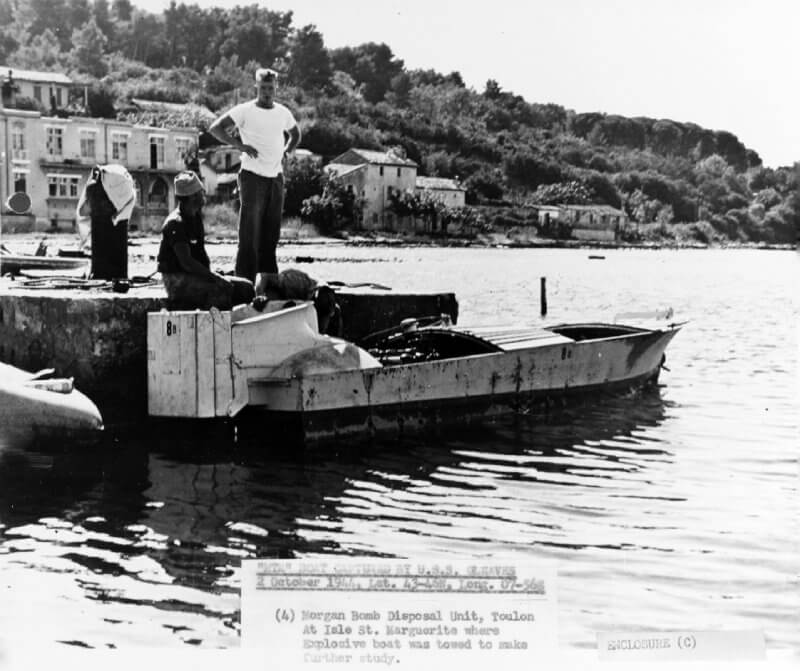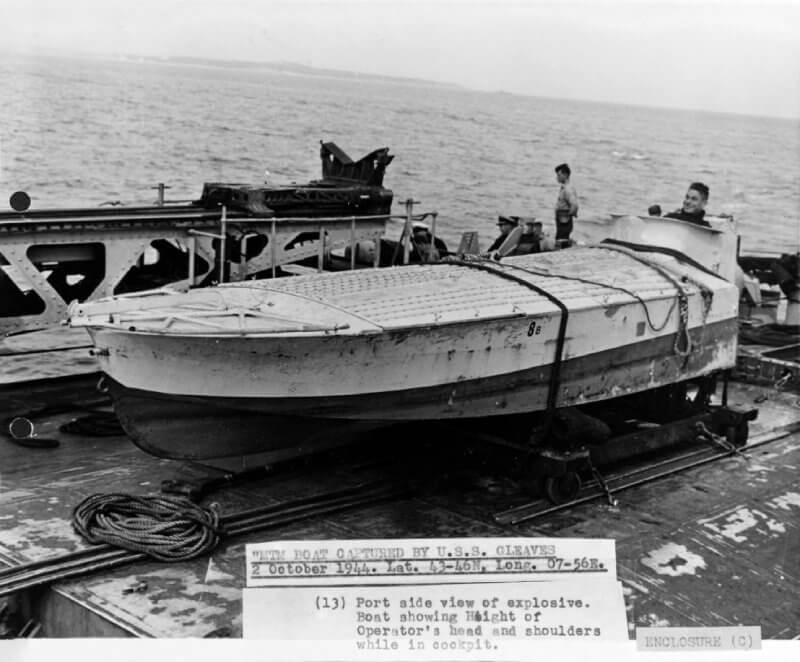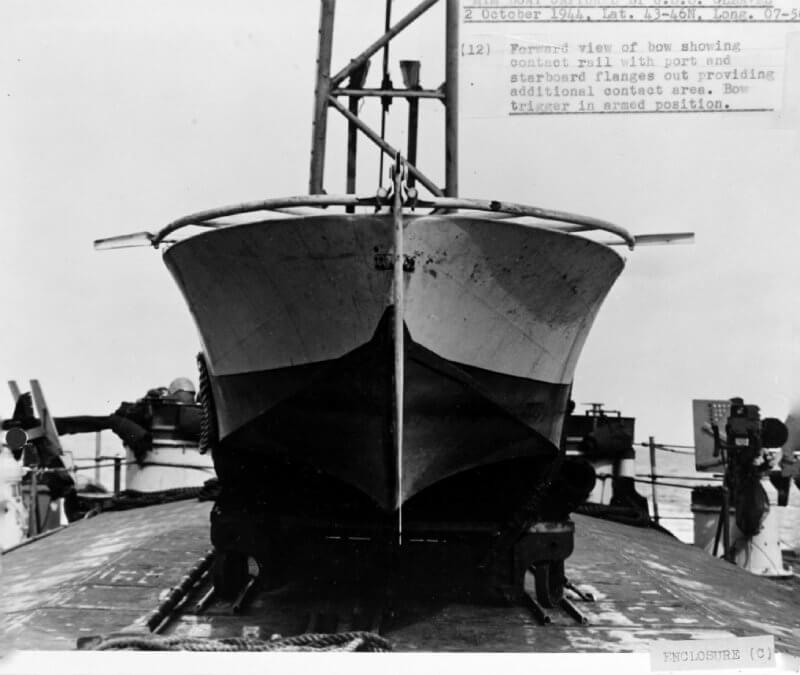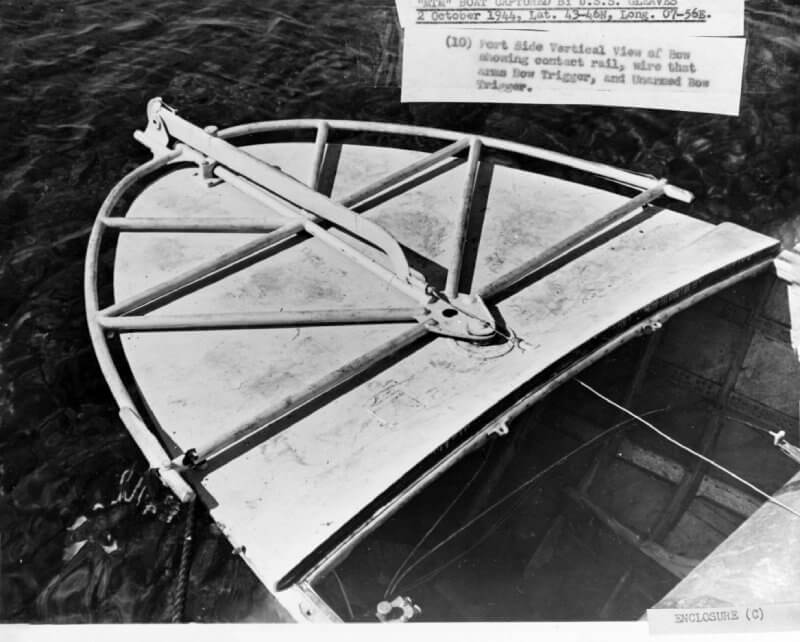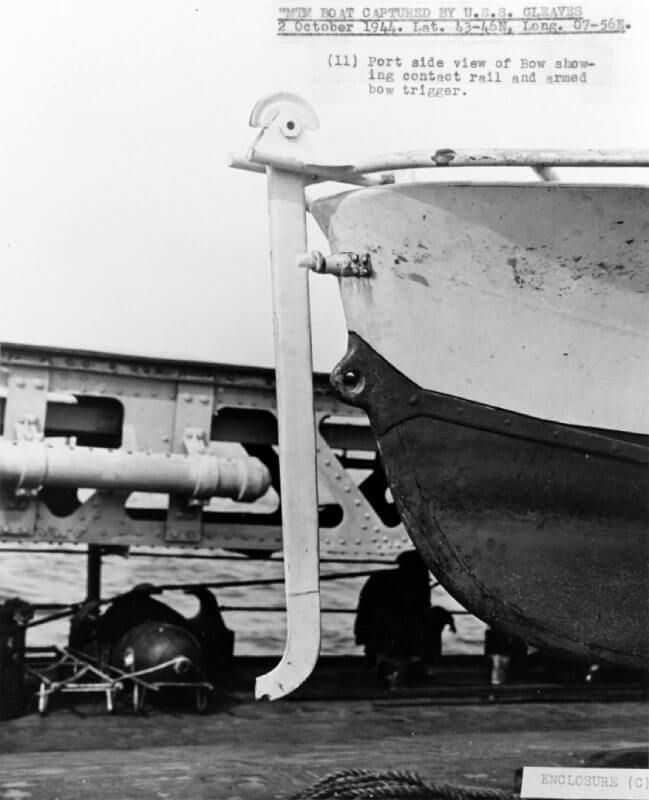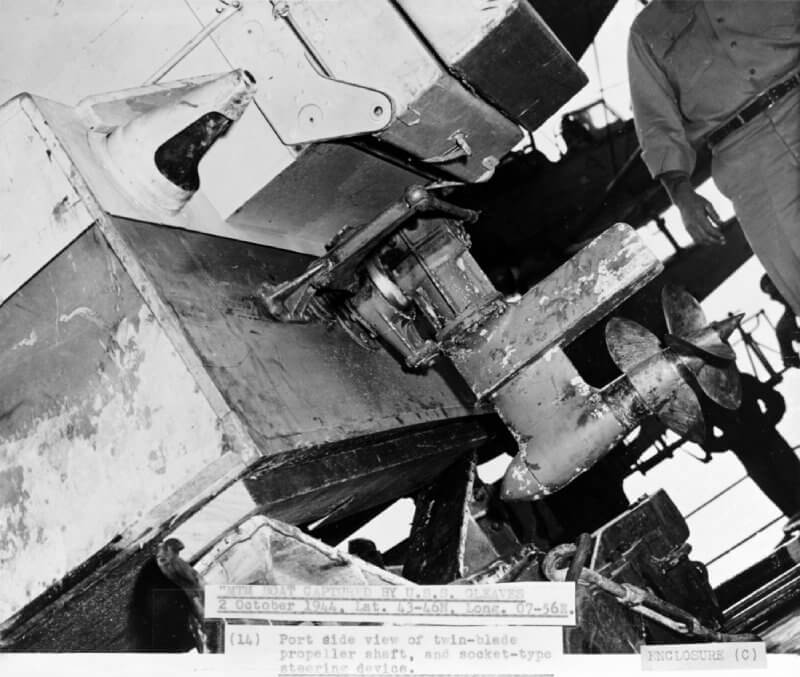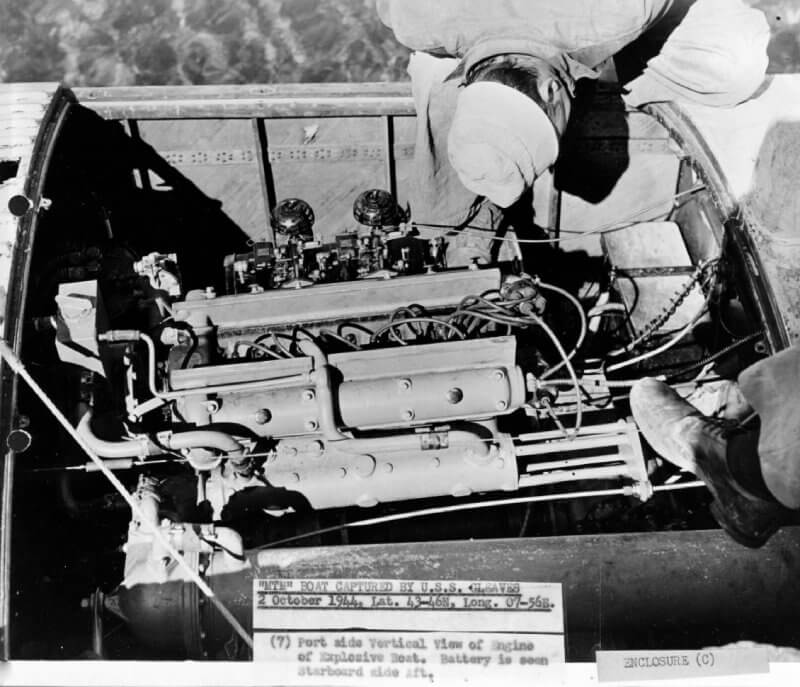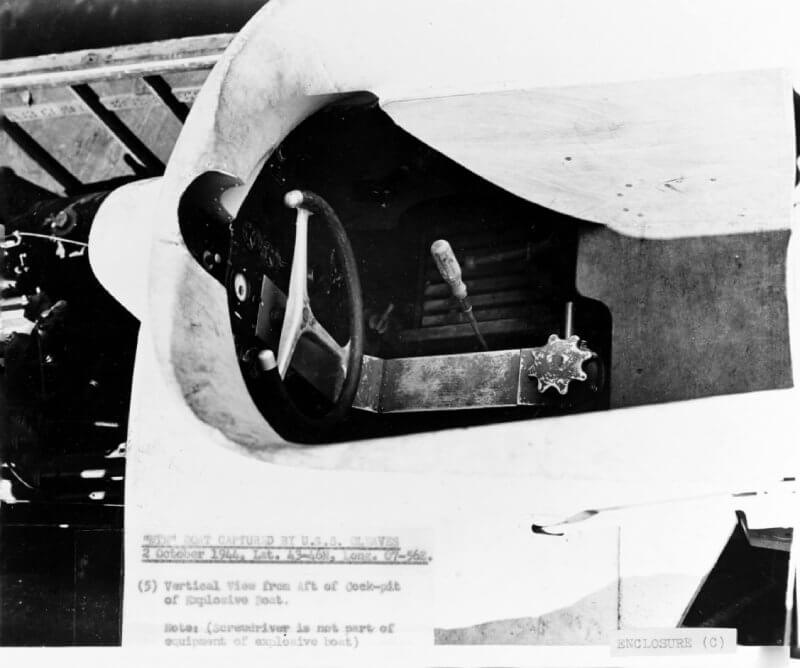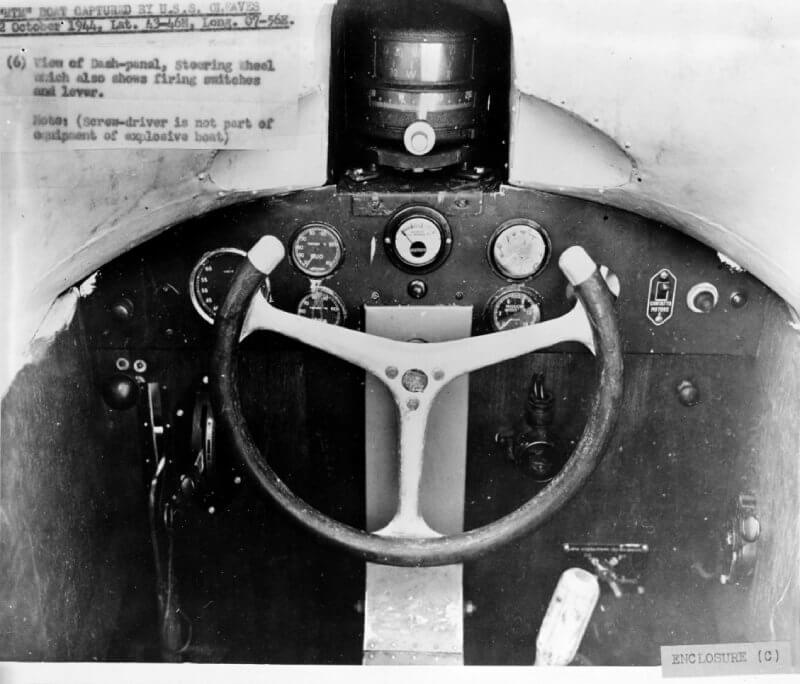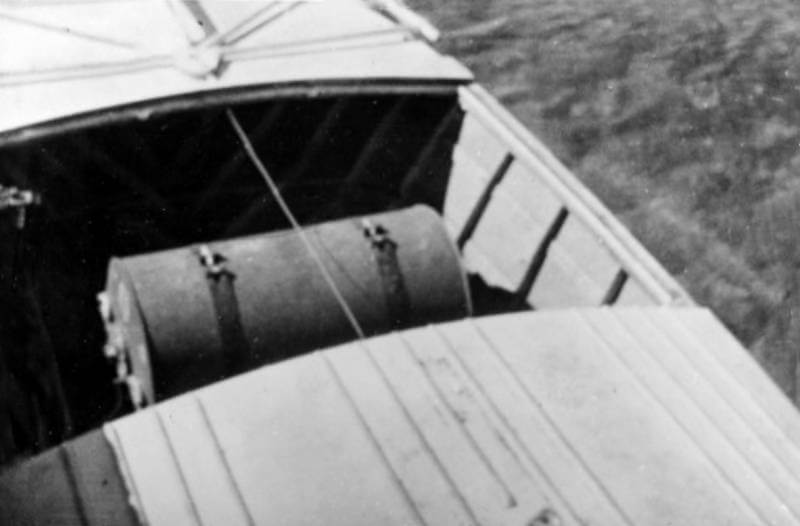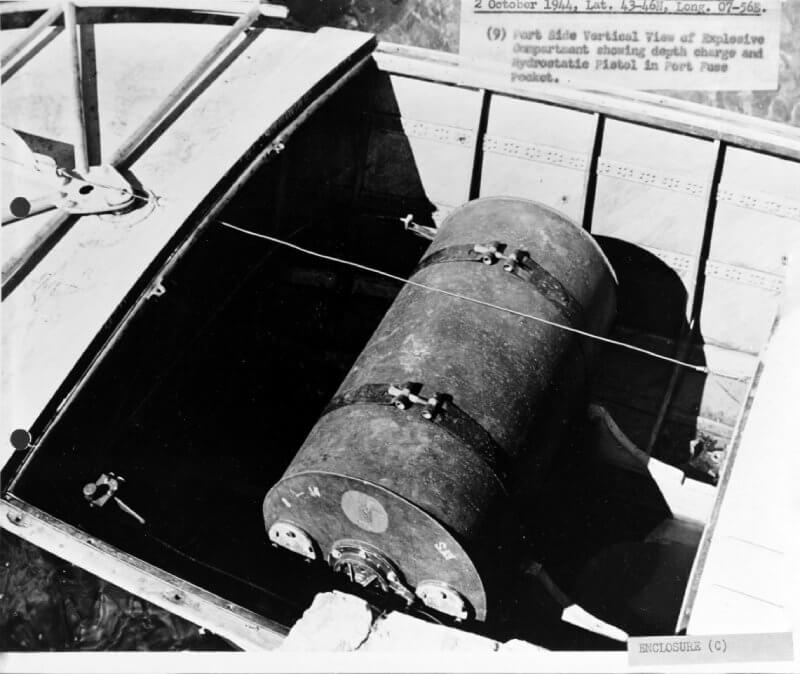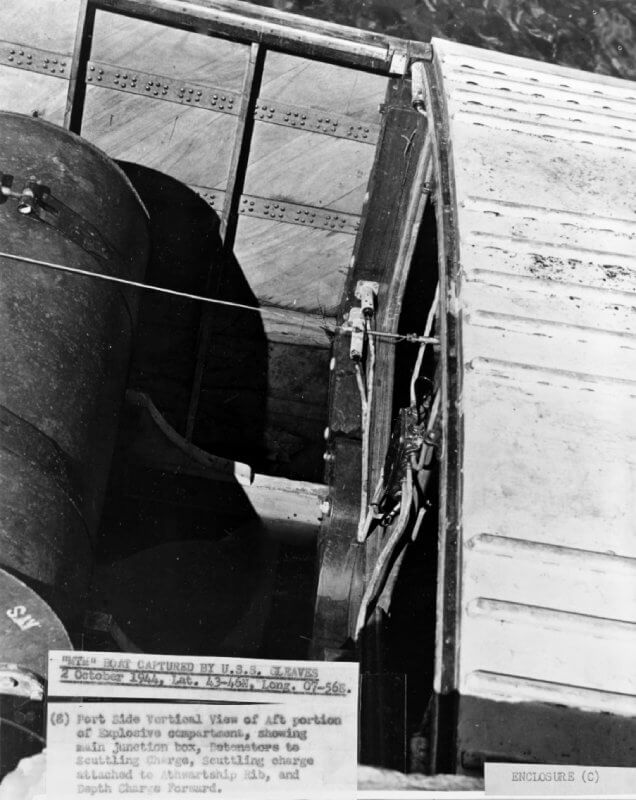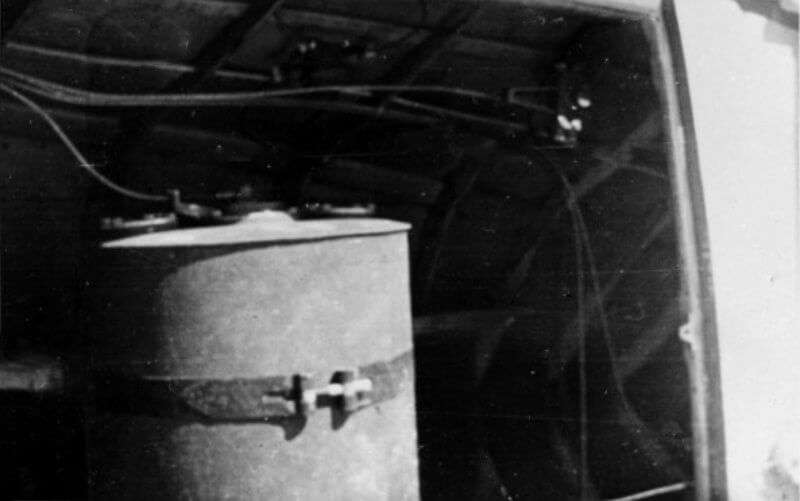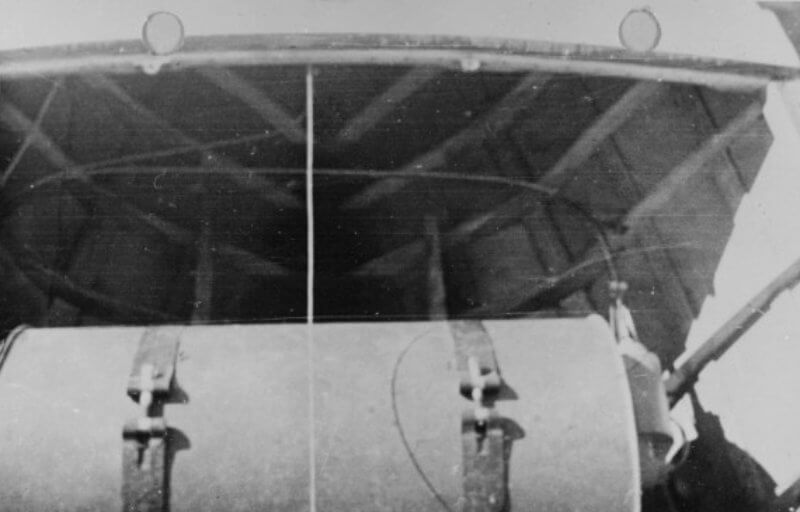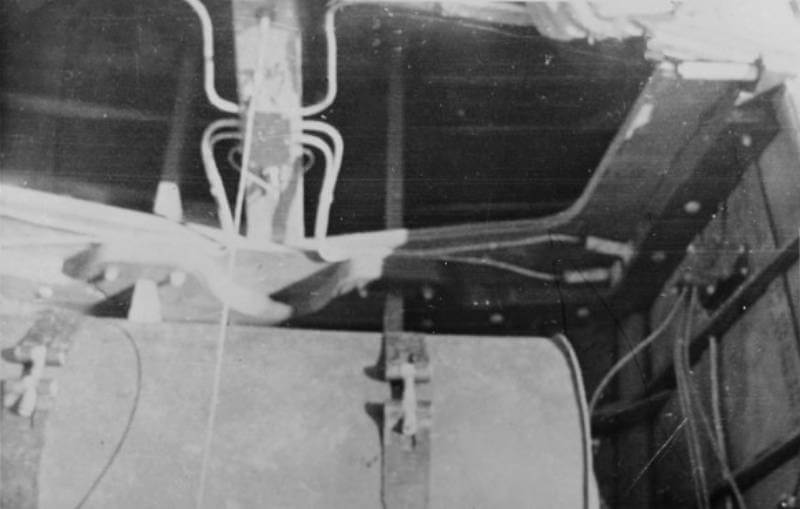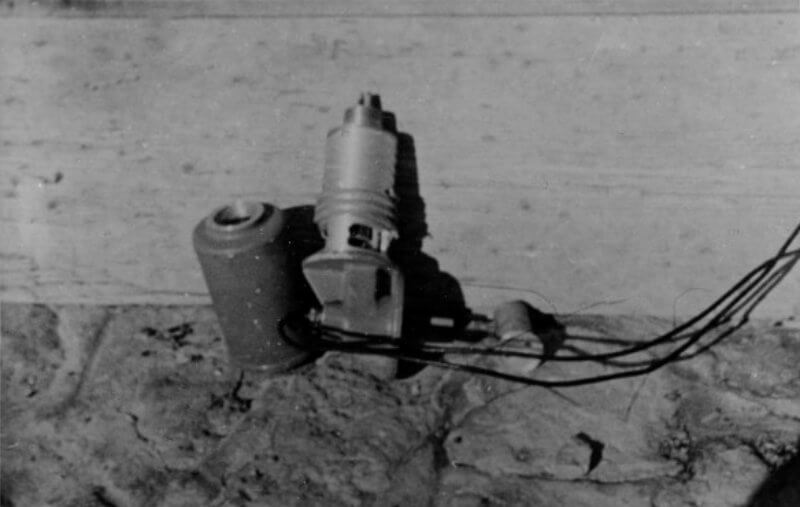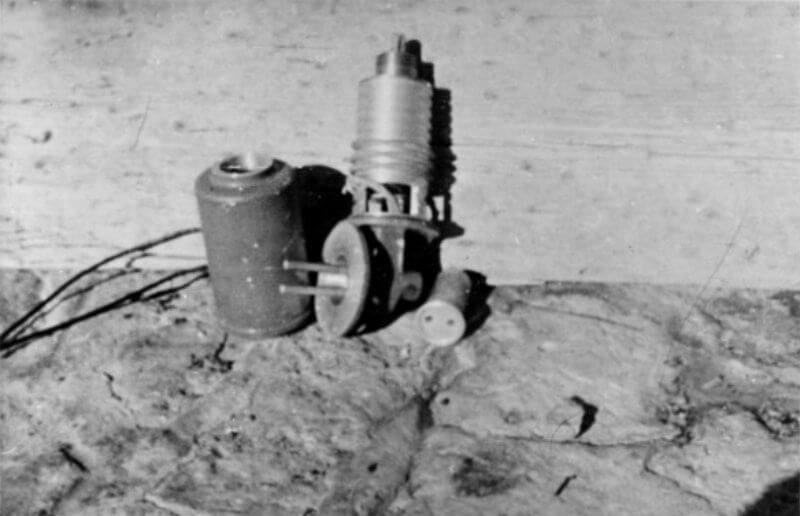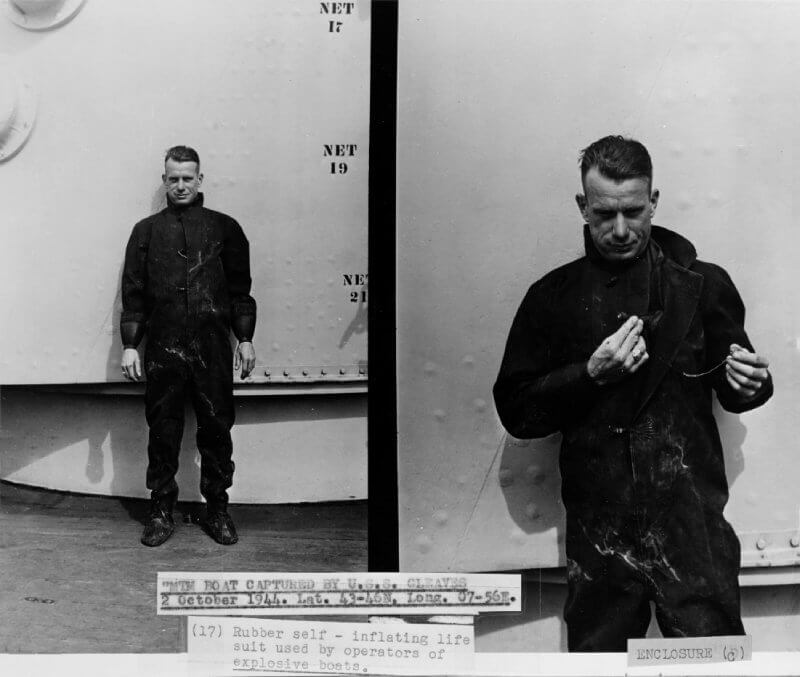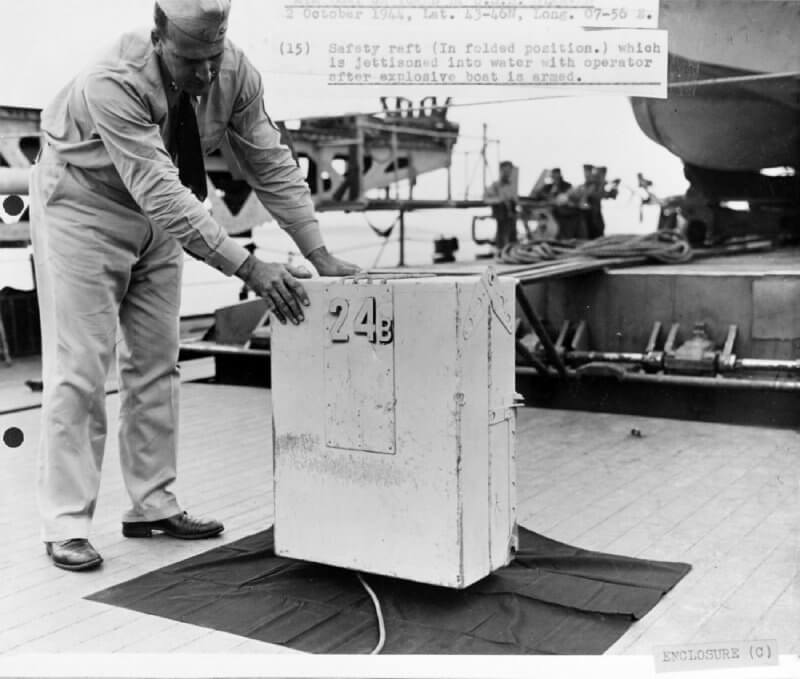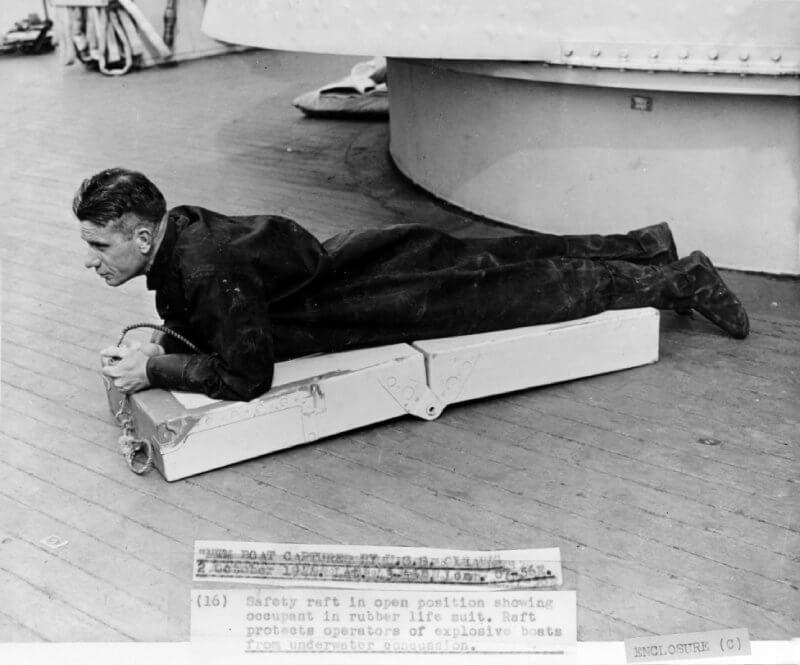| Length |
| 6.15 metres |
| Wide |
| 1.68 metres |
| Height |
| Weight |
| 1,400 kilograms |
| Propulsion |
| Alfa Romeo 2300/la six-cylinder internal combustion engine |
| Armour |
| – |
| Armament |
| 300 kilograms cylindrical TNT cartridge |
| History |
 |
| Motoscafo Avio Trasportato / Motoscafo d’Assalto |
On November 27th, 1935, Admiral Aimone di Savoia-Aosta, Duke of Spoleto, submits a comprehensive study to the Ministry of the Navy. In 1935, during the Ethiopian crisis and the redeployment of the Home Fleet to the Mediterranean, the looming threat of armed conflict between Italy and Britain prompted Amedeo Duca d’Aosta, Commander and pilot of the fighter wing at Campoformido, to draft a proposal. In collaboration with his cousin Admiral Aimone Savoia Aosta, Duca di Spoleto, and Frigate Captains Giorgi and Margottini, he submitted the following memorandum to the Royal Navy General Staff:
The plan outlined the use of six small, lightweight, and high-speed motorboats (capable of 40 knots), each carrying an explosive charge of approximately 300 kilograms of TNT, the warhead of a torpedo. These motorboats would be suspended from six Savoia-Marchetti SM.55 seaplanes, positioned between the twin hulls.
- On a night with calm seas, the six seaplanes would transport the motorboats to the vicinity of the target naval base, landing approximately 18 kilometres offshore to avoid detection by enemy patrols.
- Once released, the motorboats would proceed silently towards the enemy base. Upon reaching the harbour entrance, the lead motorboat would ram the obstruction, detonating its explosive charge to create a breach.
- The remaining motorboats would navigate through the gap, marked by a floating light left by the lead boat and its helmsman. If further obstructions were encountered, the second boat would repeat the process.
- Once inside the port, the motorboats would accelerate towards anchored vessels, with the helmsman abandoning the craft just before impact, triggering detonation upon collision.
- The operation could involve additional motorboats (nine to twelve) and be repeated at intervals, exploiting the difficulty of establishing an effective defence in a short period.
The initial proposal for the new operation outlines all critical aspects, addressing technical challenges in detail. These include the operational range and performance of the Savoia-Marchetti S.55 flying boat, the size and characteristics of motorboats, burst charges, destruction of boom defences, explosive potential against ship hulls, and the recovery of helmsmen, referred to as Pilots at the time.
The document concludes with the authors, Amedeo Duca d’Aosta, Giorgi, and Margottini, expressing their desire to personally lead the mission if the project were approved. Fate, however, dictated otherwise. Frigate Captain Margottini lost his life commanding the destroyer Artigliere during the night of October 12th,1940. Captain Giorgi fell in action while commanding the cruiser Fiume during the Battle of Cape Matapan on March 29th, 1941. Admiral Aimone di Savoia-Aosta did not find rest in Italian waters, and Amedeo Duca d’Aosta died in captivity, laid to rest in Africa after the defence of Amba Alagi.
In the context of escalating international tensions, the Italian Navy is actively pursuing innovative weapons to offset its material disadvantages in potential conflicts with Britain and France. Consequently, the Ministry of the Navy receives the project with considerable interest.
Two Italian shipyards, Baglietto of Varazze and Picchiotti of Limite sull’Arno, are consulted regarding the hulls. Both specialise in high-speed motorboats and MAS boats. However, the Navy provides only general specifications without revealing the craft’s intended purpose or operational role. On February 29th, 1936, a meeting is held at the headquarters of the Ship Projects Committee (Maricominav) in Rome, chaired by General Giuseppe Pugliese, the designer of the Littorio-class battleships. During this meeting, Vincenzo Baglietto, owner of Baglietto Shipyards, is commissioned to design a small, high-speed motorboat capable of exceeding 30 knots. The vessel must fit between the floats of an Savoia-Marchetti S.55 flying boat, necessitating strict weight and dimension limits.
The total weight must not exceed 1,000 kilograms, inclusive of a 300 kilograms payload, 150 kilograms of fuel, and the pilot. A key requirement is a mechanical system that enables the propeller and rudder to lift, allowing the craft to overcome harbour barriers and floating obstructions. Additionally, the craft must maintain a steady course after the pilot abandons it, locking the rudder in place.
Several months earlier, Engineer Baglietto, in collaboration with Engineer Guido Cattaneo, designs and constructs the Asso RB racing speedboat, featuring a unique Z-shaped transmission system developed by CABI-Cattaneo of Milan. This system can pivot horizontally, providing the basis for the new project. Following authorisation, Baglietto’s shipyard introduces CABI to the design requirements, initiating a long-standing collaboration that yields numerous surface assault craft throughout the war. Engineer Cattaneo assumes responsibility for designing the propulsion system. This includes a swivelling and lifting stern drive with counter-rotating propellers, eliminating heeling torque and ensuring stable navigation.
The limited hull depth, constrained by the 0.8-metre gap between the aircraft floats and wing centre section, presents a challenge. This is resolved by mounting a 90 hp Alfa Romeo 6C 2300 engine, similar to auxiliary engines fitted on the MAS 500-class boats, in a ‘lying’ configuration, rotated 90 degrees on its side.
While design and planning progress, the Regia Marina orders the construction of a wooden mock-up of the light motorboat (referred to as barchino). By March 23rd, 1936, the mock-up is completed and transported to the Regia Aeronautica base in Orbetello for transport trials with the Savoia-Marchetti S.55 flying boat. Testing commences shortly thereafter under strict secrecy, including flotation, take-off, and landing assessments, continuing until June 1936. Initial tests reveal significant complexities in adapting flying boats for motorboat transport and deployment. However, the trials do not rule out the feasibility of using S.55 aircraft as carriers for the light motorboats.
On June 15th, 1936, following design adjustments based on these tests, the Regia Marina commissions Baglietto to construct two prototypes. CABI-Cattaneo is responsible for mechanical components, while the Navy will handle final outfitting, including explosive charges and fuses, to maintain secrecy.
The two prototypes are completed by November 1936 at the Varazze shipyard and partially assembled in Milan. By the end of outfitting, the craft weighs 1,050 kilograms, exceeding the target weight. Efforts to reduce weight include replacing the mahogany deck with aluminium and waterproof canvas at the bow, and drilling lightening holes in the bulkheads, reducing the weight to 950 kilograms.
Sea trials at Varazze on 23 November 1936 achieve a top speed of 32.4 knots. However, endurance tests reveal inadequate engine ventilation due to limited air intake. Modifications are made, and by December, the prototypes are transferred to the La Spezia dockyard for final outfitting.
The craft receives the designation Motoscafi Avio Trasportati (MAT), translating to Air-portable Motorboats. Internally, they are also referred to as Motoscafo d’Assalto (MA) translated as Assault Motorboats, while some documents list the cover name Gamma Device.
The Motoscafi Avio Trasportati features a wooden hull constructed with a low V-bottom and two steps at frames 6 and 7. The hull is divided into sections by non-watertight bulkheads, separating the engine compartment, explosive charge area, and steering position. The hull measures 4.7 metres in length, with an overall length of 5.25 metres. The beam of the vessel is 1.46 metres, while the hull depth stands at 0.65 metres.
The craft is powered by a 75 hp Alfa Romeo 6C 2300/1 six-cylinder engine, operating at 4,400 rpm. The engine is mounted at a 10-degree angle and connects to a stern drive featuring contra-rotating propellers. Fuel capacity allows for a maximum operational range of 129 kilometres at full speed.
Steering is conducted from the stern via a truck-like spoked wheel. The rudder can be locked in place to maintain course once the pilot exits the craft. A cantilevered seat at the stern tilts backward, allowing the pilot to disembark swiftly.
The explosive payload comprises a 300 kilograms charge housed in a cylindrical casing at the bow. Upon collision, the ‘palmola’ device triggers smaller charges, splitting the vessel and submerging the bow. A hydrostatic fuse detonates the main charge beneath the target. If this mechanism fails, a timer activates the explosion within 90 seconds.
| Motoscafi da Turismo |
Following the resolution of the Ethiopian crisis, development is temporarily suspended. Prototypes are stored in naval depots until late 1938, when the project is revived. The Royal Navy places an order for six new boats, known as Motoscafi da Turismo (MT), from Baglietto and CABI Cattaneo.
On September 29th, 1938, the General Staff proposes the construction of 12 new motorboats to the Ministry of the Navy. These are to be based on the two Motoscafi Avio Trasportati prototypes already developed but with key modifications. The hull length is extended by approximately 40 centimetres, increasing from 5.25 metres to 5.62 metres. One of the two bottom steps is eliminated to enhance course stability, accepting a slight reduction in maximum speed, which is offset by installing a more powerful 90 hp Alfa Romeo 6C 2500 engine.
In October 1938, the Baglietto Shipyard receives an order to build six light motorboats under the cover name Motoscafi da Turismo, a designation that will later apply to all surface assault craft of the Italian Navy. CABI-Cattaneo of Milan is responsible for producing the mechanical components, while the Navy oversees the final outfitting. One of the original prototypes is sent back to the Varazze shipyard to serve as a reference, stripped of equipment that might reveal its operational purpose.
The six Motoscafi da Turismo boats are scheduled for delivery by December 15th, 1938, but construction is delayed, and mechanical fitting-out does not commence until February 1939. Concurrently, contracts are issued for the construction of an additional 12 boats identical to the current batch. The order is formalised in March 1939, and the first six Motoscafi da Turismo boats are completed by late spring.
Following final outfitting, sea trials at La Spezia reveal technical issues that threaten the boats’ efficiency. Notable problems include the bow’s waterproof canvas cover, which proves insufficiently robust, and the engine’s sideways installation, which allows delicate electrical components to come into contact with bilge water.
By the end of summer 1939, the six initial boats are returned to the manufacturers for modifications. The bow canvas cover is replaced with plywood, and the engine is repositioned upright, increasing the vessel’s depth to approximately 0.9 metres. A special rigid raft or lifebuoy is introduced, designed to fold and form the pilot’s seatback, releasing automatically during the pilot’s disembarkation.
Construction of the 12 second-series Motoscafi da Turismo boats is suspended until the modifications to the first series are successfully tested. Production resumes in mid-1940, with the second series completed by the end of the year. These vessels are identical to the modified first series.
Meanwhile, Baglietto Shipyard and CABI-Cattaneo continue development efforts to enhance the motorboats’ performance. In January 1940, the ‘Gamma III’ design is created, followed by the Motoscafi da Turismo Unificato (Unified MT) in June. The Motoscafi da Turismo Unificato features a pronounced convex deck cross-section and extends the overall length to 5.75 metres. Despite these efforts, further trials reveal significant shortcomings in seakeeping and course stability, prompting a substantial redesign.
| Motoscafo Turismo Modificato |
A new prototype, designated as the Motoscafo Turismo Modificato, (MTM) translated Modified Touring Motorboat, is developed under CABI’s A.326 design, dated November 25th, 1940. This prototype introduces major improvements. The hull length is increased to 5.4 metres, extending the overall length to 6.15 metres, which enhances stability and capacity. The beam is widened by 0.3 metres to improve buoyancy and handling. A stepless hard-chine hull is adopted, featuring a deep V-bow to enhance seaworthiness and course stability in rough waters. The engine is fitted with a reversing gear, simplifying approach manoeuvres and improving navigation near obstacles. Endurance is extended to three hours at full power, allowing for longer operational missions.
The main explosive charge is repositioned and secured directly to the floor instead of the keel, reducing the risk of instability. An electric trigger system is incorporated for the separation mechanism (cannon), providing greater precision and reliability. The palmola device (the striker mechanism) is relocated from inside the hull to the deck at the bow, preventing water ingress and ensuring smoother operation. The palmola is enhanced with a whisker attachment, allowing for effective targeting of both ships and obstructions. A central transverse bulkhead is installed at the craft’s centre of gravity, fitted with a single lifting point for ease of handling. The cockpit bulkhead is made watertight, improving overall durability and protecting internal components. The pilot’s position is redesigned for enhanced comfort and spray protection, increasing operational efficiency and reducing fatigue.
The Motoscafo Turismo Modificato prototype undergoes successful trials at Milan Seaplane Base on March 1st, 1941, achieving a top speed of 33 knots at full load (1,100 kilograms). On March 25th, 1941, six Motoscafi da Turismo boats participate in the first wartime operation at Suda Bay, Crete.
In March 1941, the Regia Marina orders 12 Motoscafo Turismo Modificato from CABI with hulls produced by Baglietto. Additionally, CABI is tasked with developing smaller explosive boats transportable within submarine watertight cylinders, resulting in the Motoscafo Turismo Ridotto design.
The initial Motoscafo Turismo Modificato boats require operational adjustments and are not delivered until autumn 1941. The unsuccessful assault on Valletta Harbour on July 26th, 1941 highlights the vulnerability of surface transport near enemy bases. This leads to a focus on developing submarine-transportable craft. Despite this shift, Motoscafo Turismo Modificato’s remain in production and see continued use from coastal bases and mobile launch platforms.
Between March 1941 and September 1943, approximately 40 Motoscafo Turismo Modificato are ordered. The first 12 are completed in autumn 1941, while subsequent batches (series IV to VIII) are delivered before the 1943 armistice. Italian records indicate hull numbers between 1 and 199, generally using even numbers.
Post-armistice, the Italian Social Republic’s, Xa Flottiglia Mas continues using Motoscafo Turismo Modificato and commissions new units identified by the suffix b or by the 500-series produced by SIAI as CABI subcontractors. By the end of 1943, a small contingent of Motoscafo Turismo Modificato’s remain in Amalfi and Sardinia under Regia Marina’s, Mariassalto control but is not deployed in combat.
At the end of the World War 2, most operational Motoscafo Turismo Modificato in Xa Flottiglia Mas service are deliberately destroyed. However, quite some units commissioned by the Germans or in various stages of construction are recovered. Additionally, a dozen Motoscafo Turismo Modificato supplied to Mariassalto survive. The Allies capture several of these units during and after the conflict.
| Motoscafo Turismo Ridotto |
During early 1941, it becomes apparent that alternative methods of approaching targets are necessary to simplify procedures and reduce the risk of detection associated with using surface vessels as carriers. Drawing inspiration from the Siluro a Lenta Corsa, submarines are proposed as the new carriers, utilising the same watertight cylinders used for underwater self-propelled craft.
The primary challenge lies in the dimensions of the standard explosive motorboats. To address this, a smaller variant is developed, officially designated as the Motoscafo Turismo Ridotto, though commonly referred to by staff simply as “erre” (R). Building on the Motoscafo Turismo Ridotto’s design, an improved version, the MTRM, is already under development prior to the 1943 armistice.
One of the earliest technical documents detailing this smaller motorboat is CABI drawing A.550, dated 28 February 1942. While the length remains comparable to the Motoscafo Turismo Modificato, the beam is reduced by approximately 60 centimetres. Like the Motoscafo Turismo Modificato, the Motoscafo Turismo Ridotto features a hard-chine, unstepped hull. Fully loaded, the craft weighs 1,250 kg, with overall dimensions of 6.185 metres in length, 1.080 metres in beam, and 1.14 metres in depth. These measurements account for the stern drive being raised and the temporary removal of the windscreen and compass, which are reinstalled upon launch.
The submarines’ transport cylinders measure approximately 6.6 metres in length with an internal diameter of around 1.15 metres. Consequently, every available inch of space is optimised. The life-raft sections, which differ significantly from those of the Motoscafo Turismo Modificato, are shortened to 0.425 metres in length and 0.5 metres in width, while maintaining a depth of 0.15 metres. The hull sides are noticeably more convex compared to the near-vertical profile of the Motoscafo Turismo Modificato. To maximise space, the explosive charge and cylindrical petrol tank (measuring 37 by 50 centimetres) are placed directly on the keel rather than on the floor. The refuelling nozzle is hidden within a recessed deck compartment, eliminating protrusions, and the air intakes are replaced by a rectangular, front-hinged hatch. The lubrication oil tank and battery are relocated to the right side of the engine compartment.
While the increased length-to-beam ratio improves speed, it severely reduces the already limited seakeeping capabilities of the motorboat. However, this drawback is considered negligible, given that the MTR operates only briefly between the point of release and the attack target. A larger and wider stern flap is fitted to enhance performance by optimising the effect of the coaxial propellers and water flow.
The Motoscafo Turismo Ridotto’s palmola (the striker mechanism) is simplified compared to the Motoscafo Turismo Modificato but incorporates five side ‘whiskers’ on each side, providing improved engagement with obstacles.
The weight distribution of the Motoscafo Turismo Ridotto is carefully planned to ensure optimal balance and performance. The hull alone accounts for 680 kg of the total weight. The pilot adds an additional 80 kg. Fuel and oil contribute a further 80 kilograms. The raft-lifesaver weighs 21 kg, while the explosive charge and its casing add 350 kilograms. Various auxiliary devices make up the remaining 39 kg, bringing the total displacement to 1,250 kilograms.
Propulsion is powered by the Alfa Romeo AR 2500 engine, allowing the Motoscafo Turismo Ridotto to achieve a maximum speed of 31 knots with an operational range of approximately 67 nautical miles.
Although the Motoscafo Turismo Ridotto’s design is finalised by early 1942, the craft does not see active deployment. Nevertheless, the command of the Decima Flottiglia Mas holds the Motoscafo Turismo Ridotto in high regard. By the time of the September 8th, 1943 armistice, plans are in place to deploy the Motoscafo Turismo Ridotto in operations against Gibraltar, Freetown, Cape Town, and even New York.
A total of 13 Motoscafo Turismo Ridotto’s are constructed, consisting of a prototype and 12 operational units built in three series with minor design variations. The prototype is likely completed between late 1941 and early 1942, and after trials, it is repurposed for further experimentation. Up until September 1943, the Regia Marina orders 12 production Motoscafo Turismo Ridotto’s from CABI, all delivered before the armistice.
These units receive the hull numbers 02 to 024 (excluding odd numbers), prefixed by a 0. Initially, early production Motoscafo Turismo Ridotto’s are left unpainted, retaining the natural dark wood finish, but are later repainted in light blue-grey, consistent with other Italian assault craft. By the time of the armistice, most Motoscafo Turismo Ridotto’s are concentrated at La Spezia, the principal base for submarine operations.
Following the armistice, the republican Xa Flottiglia Mas commissions a handful of Motoscafo Turismo Ridotto’s, though several units are captured by the Germans but remain unused. Another nine modified Motoscafo Turismo Ridotto Modificato units are ordered from CABI, but only one is completed before the war concludes.
As of April 1945, four Motoscafo Turismo Ridotto hulls (numbers 02, 04, 014, and 020) are known to still exist, though not all are fully operational. These are eventually discovered at the Xa Flottiglia Mas Pilot School in Sesto Calende in May 1945, lacking engines and cockpit screens.
| Motoscafo Turismo Modificato Raft |
From the earliest trials with prototypes of explosive boats, designers express significant concern for the safety and survival of the operators. Initially, there is no provision for a dedicated life-raft, a feature that only becomes standard in later designs. In the absence of the advanced Belloni suit, pilots, referred to as helmsmen at the time, are equipped with a rudimentary life-bag. This cumbersome full-body suit, padded with 10–15 centimetres of kapok (a lightweight, buoyant vegetable fibre), provides sufficient flotation. To enhance buoyancy, some pilots add standard kapok-filled life jackets issued to naval personnel. During an explosion, the operator is instructed to lie flat on the water’s surface, feet oriented towards the detonation point, to minimise injury from the underwater shockwave.
The raft adopted for the final Motoscafo Turismo Modificato explosive boat series consists of two parallelepiped-shaped sections, each measuring 0.70 metres × 0.55 metres × 0.15 metres. These sections are constructed with cellular interiors made of hardwood strips and are externally covered with beech plywood panels, interlayered with waterproof canvas. The two parts are connected at the top by a flat, anti-corrosion metal hinge, allowing them to fold together compactly. In their folded state, the life-raft serves as both the cockpit’s aft closure and the pilot’s backrest. It is secured to the edges of the canopy with brass ring latches that lock into dedicated sockets and are held by hooks or pawls.
Upon deployment, lifting the red burst lever activates various devices, including the mechanism that releases the life-raft restraints. The raft, along with the pilot leaning against it, drops into the water. Elastic cables (4–5 in number) automatically open the raft into a flat support base, ensuring rapid readiness for use.
When explosive boats are moored or rafts stored in warehouses, the rafts are kept open to maintain the elasticity of their cables. To facilitate retrieval, especially at night or in rough seas, a small line is tied to a metal ring on the far end of one raft section. The operator, once in the water, climbs onto the raft belly-down with arms and legs raised to avoid contact with the water. This must be achieved swiftly, as the boat’s explosive charge detonates shortly after impact with the target or at the end of its run.
On the first Motoscafi da Turismo boats, the raft is secured by a canvas strip instead of the later brass latches. During the attack on Suda Bay, Sergeant Emilio Barberi loses his raft when crossing a defensive barrier. Although the raft is immediately recovered, this incident highlights issues with the release mechanism. Additionally, when the folded raft is mounted on the stern, the craft’s identification number is displayed on the raft’s flat back surface. Initially painted in black, this number is later changed to yellow-gold to stand out against the grey-blue hull.
In early 1944, an electric raft is tested at Sesto Calende. This experimental raft features a small two-blade ducted propeller powered by a 0.25 hp electric motor housed in a bulb beneath the aft outer face. The motor is powered by a battery located within the raft body. To improve seaworthiness, the fore and aft lower edges are rounded, and the sections are slightly larger, measuring approximately 1.05 metres × 0.55 metres × 0.20 metres. Unlike earlier models, the hinge is placed at the bottom rather than the top. The raft also includes practical additions such as two metal handles for secure grip, a square rubber patch hiding a propeller control button, and two circular lids that provide access to storage wells for food, water, and essential tools.
However, the increased weight of the motor and battery reduces the raft’s buoyancy, particularly in even mild sea conditions. During tests on calm lake waters, this limitation becomes evident, and the design is ultimately abandoned. Attempts to use the self-propelled raft for towing operators also fail due to these buoyancy issues.
| Operational Use |
On March 25th, 1941, six Motoscafi da Turismo boats conduct their first wartime operation at Suda Bay, Crete. Between 16:30 and 17:30, the destroyers Quintino Sella and Francesco Crispi of the Fourth Squadron depart from Stampalia, bound for a position 9.6 kilometres off the Akrotiri Peninsula. By 23:30, they arrive at the designated location and deploy six explosive boats into the water. Within minutes, the destroyers begin their return journey to base at 23:41.
The explosive motorboats advance towards British vessels moored at Suda Bay, launching a coordinated assault. The attack causes severe damage to the heavy cruiser H.M.S. York and the tanker Pericles, leaving both ships partially submerged. Although the operation is successful in damaging the targets, all six Italian pilots are captured by British forces as expected by the Italian Navy.
In June and July 1941, the Italian Navy plans an assault on British ships anchored at Valletta, Malta. The mission is carried out by Decima Flottiglia MAS, Italy’s elite naval commando unit, and involves the use of Motoscafi Turismo Modificato and other specialist assault craft.
Reconnaissance missions are conducted on the nights of May 25th, 1941, to May 26th, 1941, and May 27th, 1941, to May 28th, 1941. Italian MAS boats approach within 7.4 kilometres of Valletta without alerting British defences. Encouraged by the results, the Italian Navy schedules the attack to coincide with the next new moon at the end of June. The mission is designated Operazione Malta Uno. Another reconnaissance mission on the night of June 25th, 1941, to June 26th, 1941, brings MAS boats within three kilometres of the coast. This further boosts confidence among the Italian commanders.
On the afternoon of June 27th, 1941, the operation begins from the naval base at Augusta in Sicily. Five MAS boats tow nine Motoscafi Turismo Modificato. The Motoscafi Turismo Silurante and one of the Motoscafi Turismo Modificato are towed by MAS 452. The remaining four MAS boats, MAS 451, MAS 509, MAS 556, and MAS 562, tow two Motoscafi Turismo Modificato each. As the force makes its way toward Malta, rough seas swamp one of the Motoscafi Turismo Modificato, forcing the entire group to abandon the mission and return to base.
A second attempt takes place on the night of June 29th, 1941, to June 30th, 1941. Eight Motoscafi Turismo Modificato are towed to the target zone. However, rough weather again hampers progress. One of the craft sustains damage and is returned to Augusta by its MAS boat. The remaining Motoscafi Turismo Modificato are redistributed among the MAS boats, and the force resumes the approach. Later that evening, one of the tow cables snaps, leaving the Motoscafi Turismo Modificato stranded. After an hour of unsuccessful repair attempts, the craft is scuttled at 22:00 to prevent capture.
Shortly after resuming the approach, one of the MAS boats experiences engine failure. Although repairs are eventually completed, the delay forces the Italians to call off the attack. With dawn approaching, the risk of detection is too great, and the fleet returns to base.
The Italian Navy reschedules the operation for the night of July 25th, 1941, to July 26th, 1941, renaming the mission Operazione Malta Due. Adjustments are made to address the issues encountered during the earlier attempts. The number of MAS boats is reduced to two, MAS 451 and MAS 452. The Aviso Diana is assigned to tow the larger Motoscafi Turismo Lento and to carry nine Motoscafi Turismo Modificato and one Motoscafi Turismo Silurante. The Motoscafi Turismo Lento is also fitted to carry two Siluro a Lenta Corsa. These are intended to breach the torpedo nets by 04:30, creating a gap for the Motoscafi Turismo Modificato to enter the harbour and target British ships at anchor.
To aid navigation and serve as a diversion, small air raids are scheduled at 02:30 and 04:15. A larger air raid is planned for 04:30 inland of Valletta to divert attention from the approaching Italian craft. Italian fighter aircraft are scheduled to take off from Comiso at 05:30 to escort the returning vessels back to base.
On the night of July 23rd, 1941, to July 24th, 1941, a final reconnaissance is conducted. The MAS boats approach within two kilometres of the Maltese coast. British searchlights sweep the area but fail to detect the Italian vessels, which return safely to base.
The final assault on Valletta’s Grand Harbour takes place on the night of July 25th, 1941, to July 26th, 1941. The mission is led by Teseo Tesei and Eliodoro Sandri. British forces at Malta are well-prepared with extensive boom defences, searchlights, and heavy patrols. As the Italian craft approach the harbour, one Motoscafi Turismo Modificato detonates prematurely, alerting British defenders. The remaining craft are either intercepted and destroyed or fail to breach the harbour’s defences.
None of the nineteen Decima Flottiglia MAS personnel survive the operation; ten are killed, and nine are taken prisoner. Out of the twenty-six MAS crew members, six are killed, nine are captured, and eleven manage to escape to Italy. One of the returnees later succumbs to wounds sustained during the mission. Additionally, one Regia Aeronautica pilot is killed during the operation.
All Motoscafi Turismo Modificato, Siluro a Lenta Corsa, and two Saettas are lost in the assault, with only the Motoscafi Turismo Silurante successfully making it back to Sicily. The British forces lose one Hawker Hurricane fighter aircraft during the engagement. They capture MAS 452, which is towed back to port by the trawler Jade. The British also recover a drifting Motoscafi Turismo Modificato and the Siluro a Lenta Corsa operated by Costa.
In July 1943, during the Allied landings in Sicily, the Italian Navy plans another mission involving three Motoscafi Turismo Ridotto. The vessels are transported aboard the submarine Ambra. However, the mission is aborted after Ambra sustains damage from an air attack.
Another operation targeting Gibraltar is planned for early October 1943. The submarine Murena, newly commissioned and fitted with four watertight cylinders, is tasked with delivering four Motoscafi Turismo Ridotto near Algeciras Harbour. The Motoscafi Turismo Ridotto are to launch at 11:00 and accelerate towards merchant ships anchored in the bay. The Italian commanders expect the ensuing panic to draw defensive forces away from the military harbour at Gibraltar. This would allow a Siluro San Bartolomeo from the Olterra to slip into the harbour and target British warships.
The attack is scheduled for October 2nd, 1943. However, the Italian surrender in September 1943 forces the cancellation of the operation, marking the end of plans to strike Gibraltar with Italian explosive motorboats.
| Multimedia |
| Photographs |
| Versions |




| Motoscafo Avio Trasportato / Motoscafo d’Assalto |
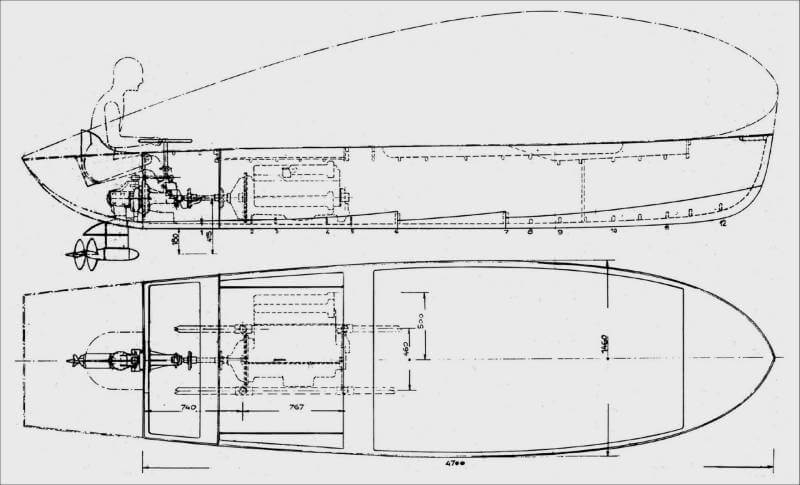
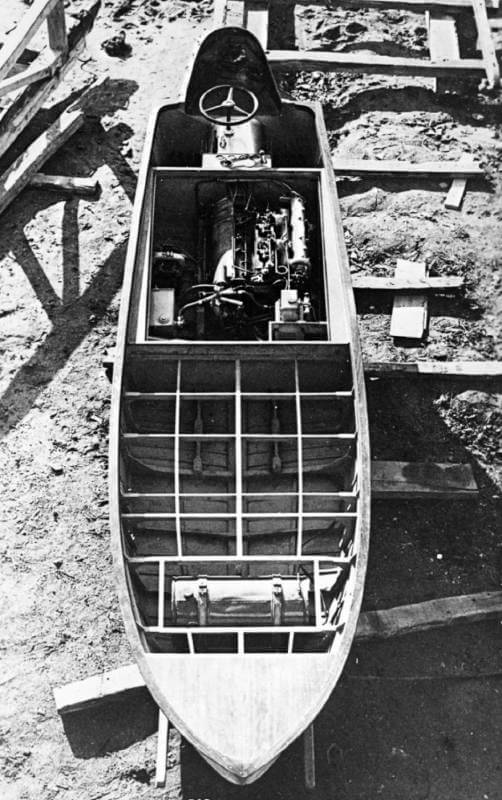
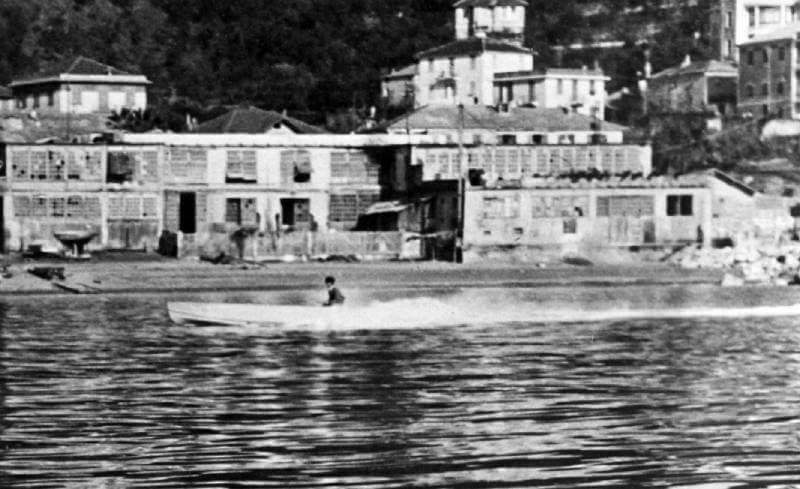
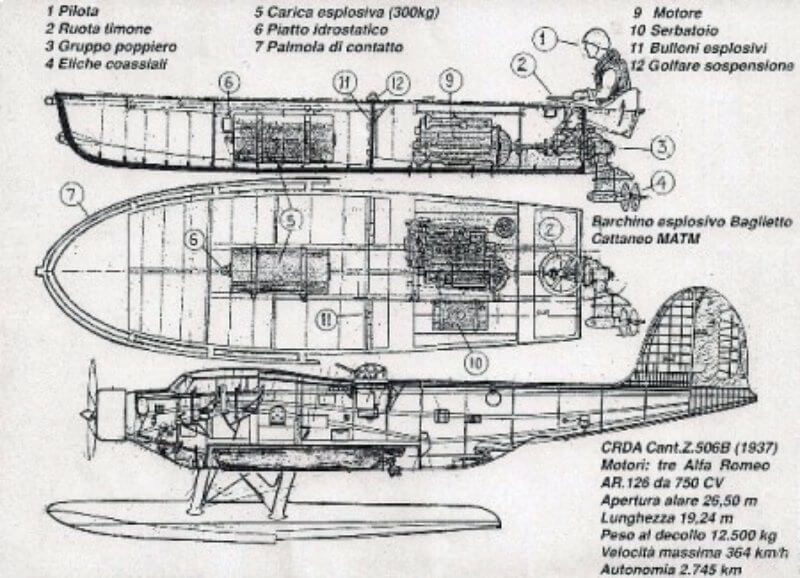
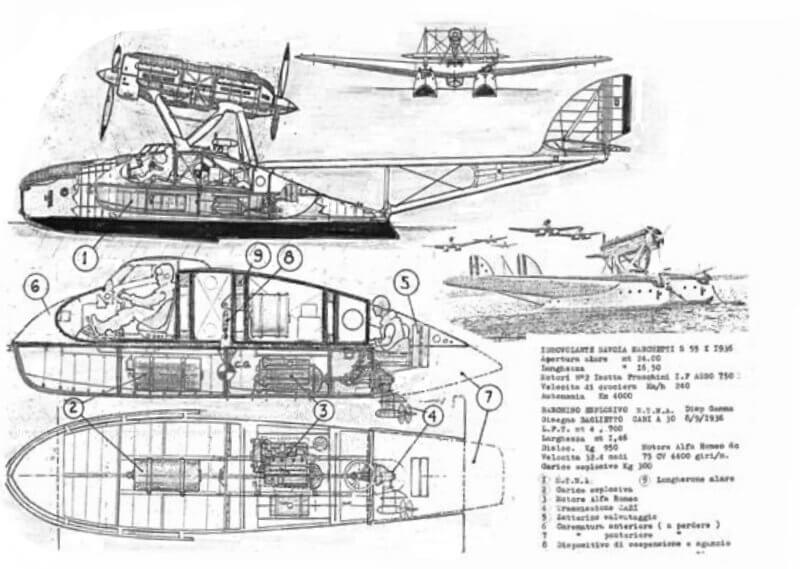
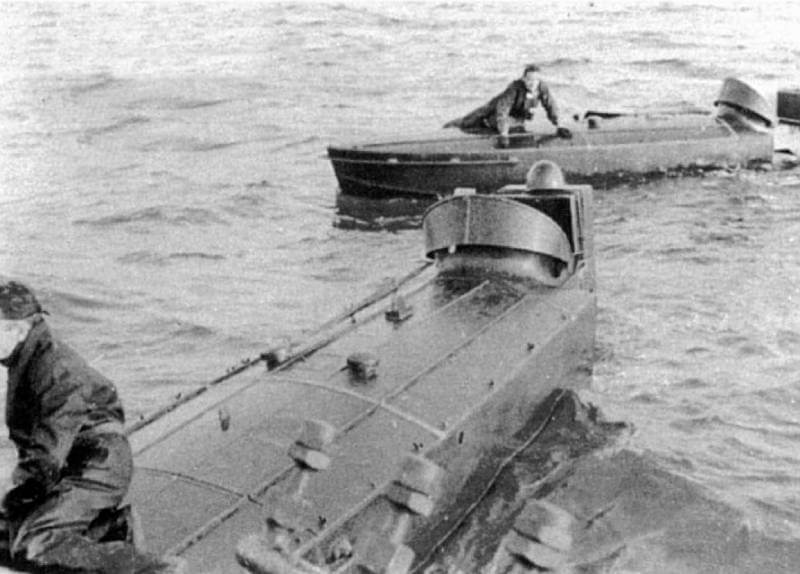
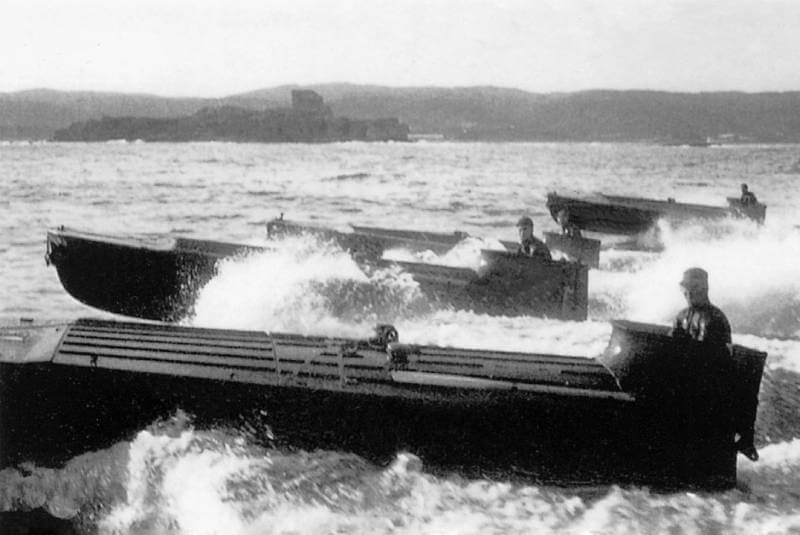
| MT-16 |
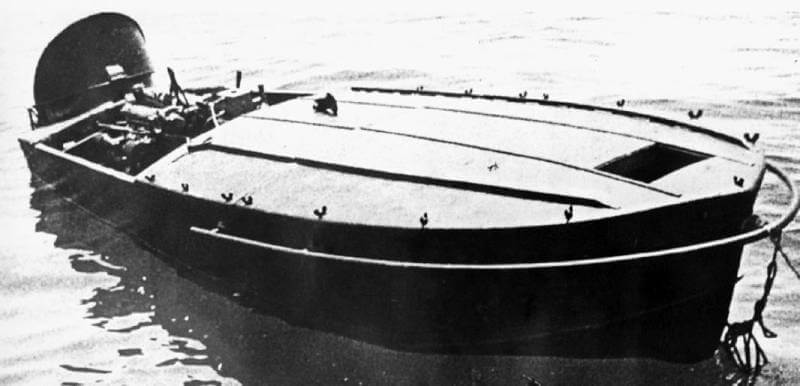
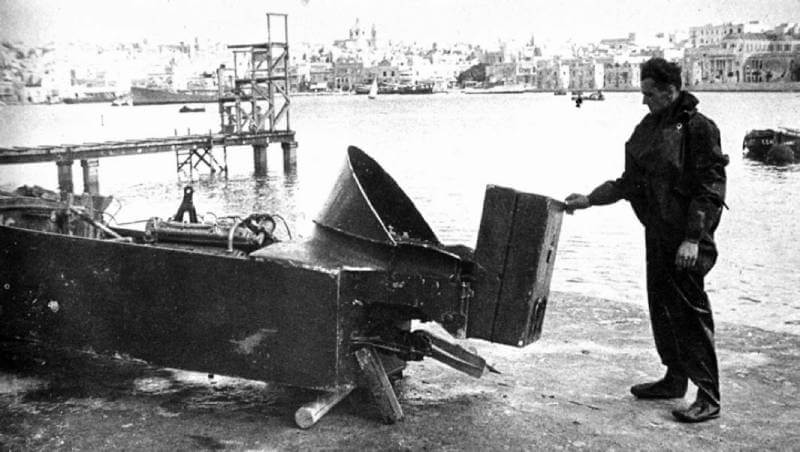
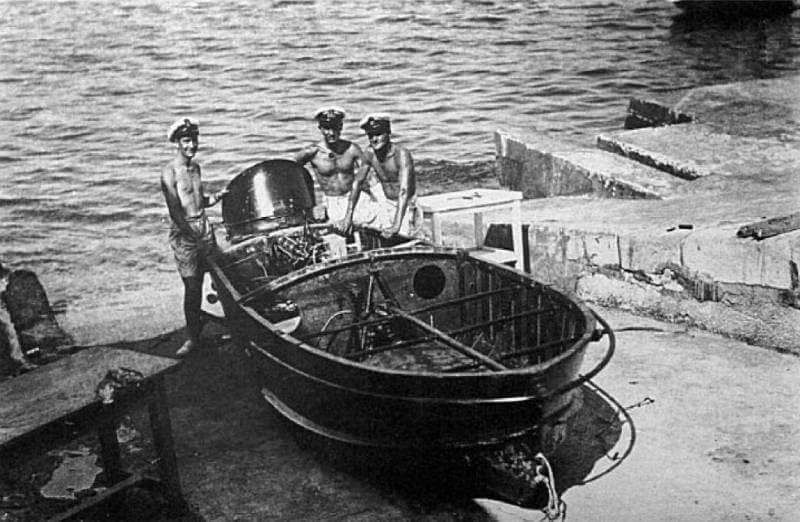
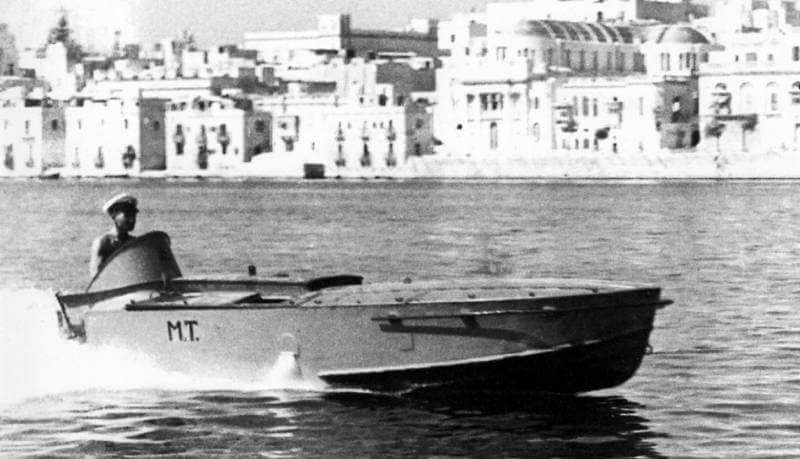
| Raft |
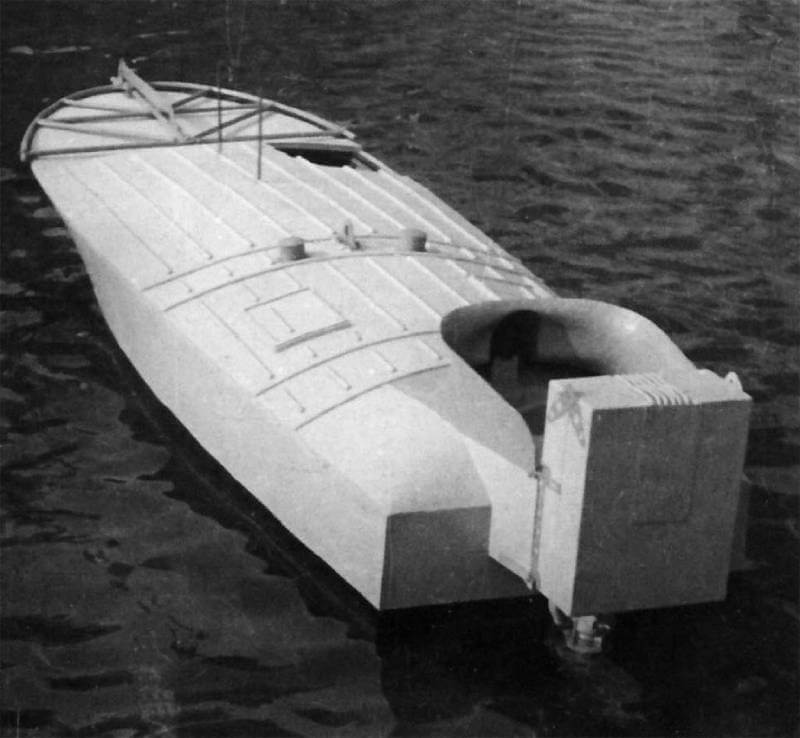
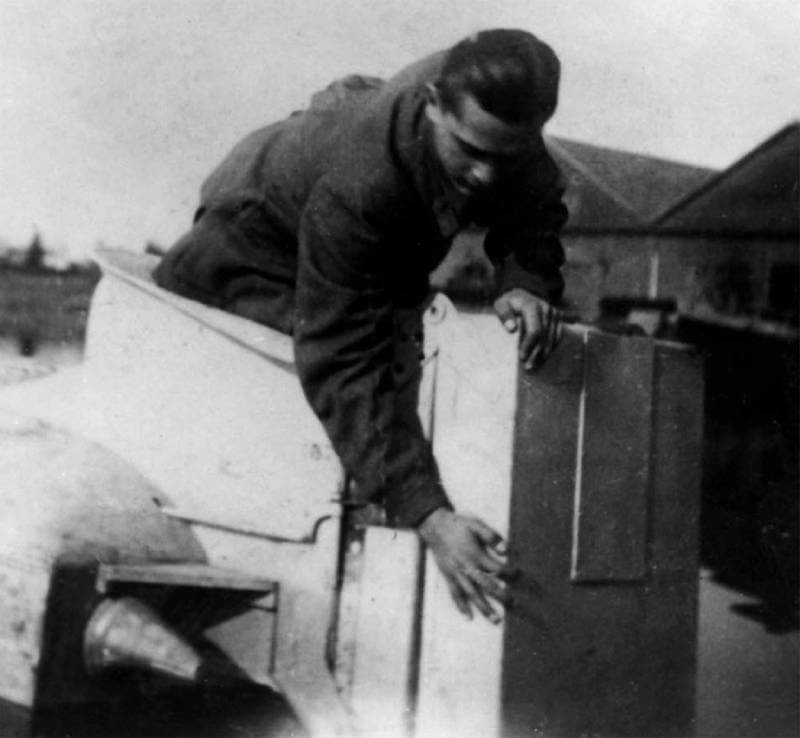
| Electric Raft |
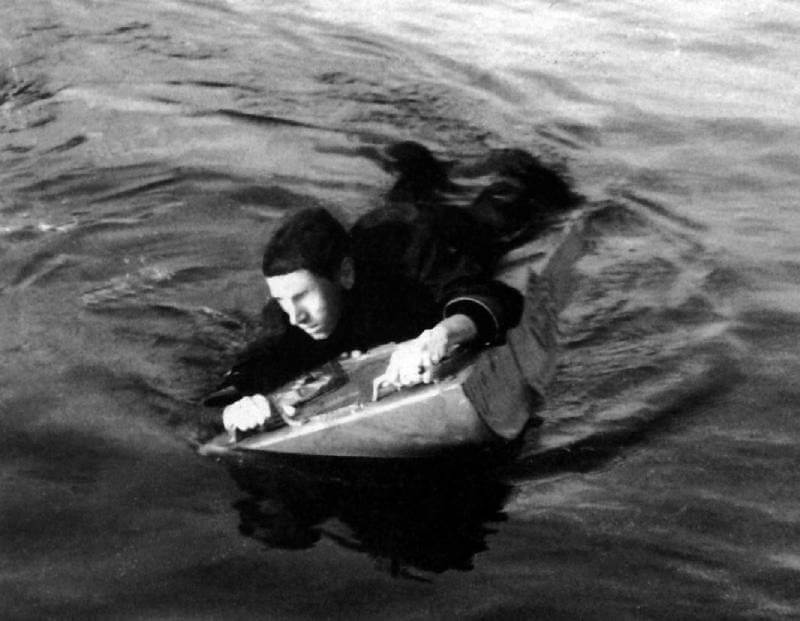
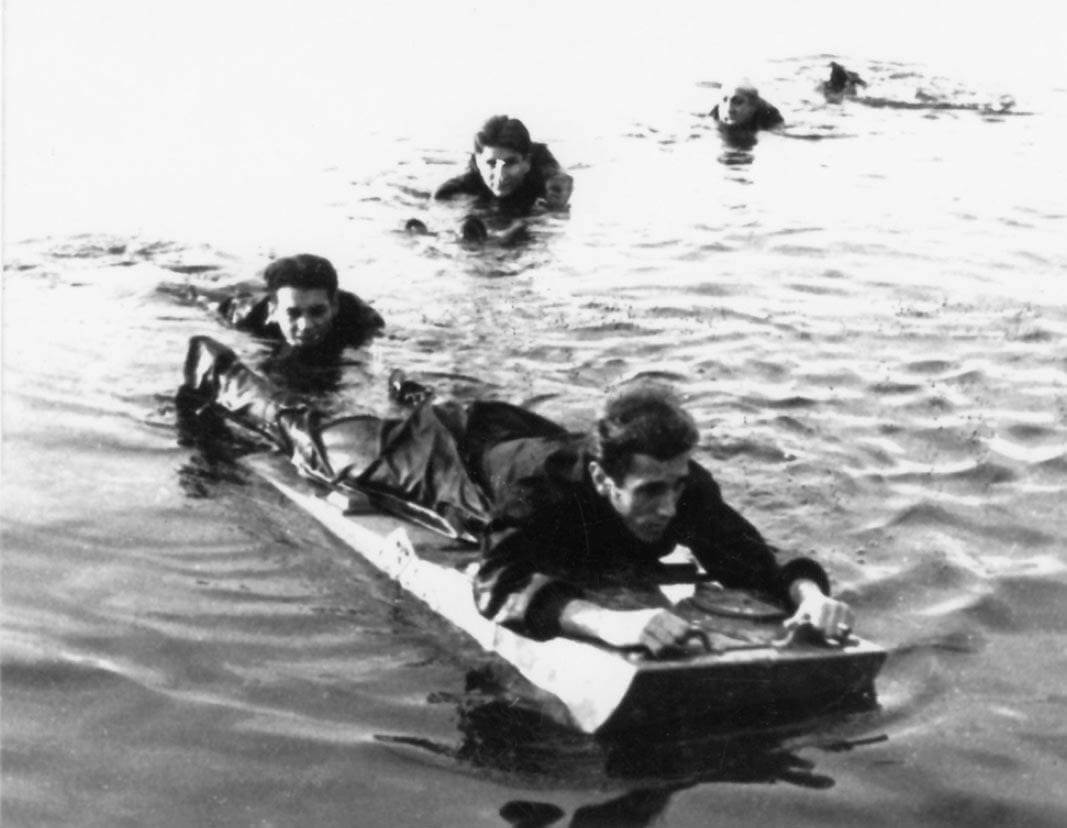
| MTM, captured by U.S.S. Gleaves (DD-423) off San Remo, Italy, October 2nd, 1944. |
